the cultivators: amber waves farm
Many of the women who I document as part of the Female Farmer Project are referred to me the same way. An email, a tweet and sometimes over the table at a dinner party -- someone will say, 'I know a female farmer that you have to meet'. This time the referral came from Jack Bishop of America’s Test Kitchen. He was on book tour and we were having a celebratory dinner and book signing at the home of Linda Nicholson of Salty Seattle. Jack told me of two women farmers were doing something remarkable in East Hampton - they were growing wheat.
I tucked that tidbit away for future reference. I live in Seattle, and East Hampton is on the very opposite side of this country, with many farms and female farmers in between. Nearly a year later I reached out to them when I learned I would be in New York, and asked if I could come out for a visit.
It’s a 6-hour round trip train ride from Manhattan to the East End of Long Island, so I got an early start from Penn station. Like a fish swimming upstream, I pushed my way through the throng of incoming commuters and found myself on a nearly empty train. I watched as we left the skyscrapers behind and headed to the suburban landscape of Long Island. As we drew closer, the strip malls and homes gave way to open spaces. I was alone in stepping off the train in quiet Amagansett, and I set out by foot to go meet the ladies at Amber Waves Farm.
I beat farmers Katie Baldwin and Amanda Merrow to the farm and took advantage of meeting the apprentices, and seeing the farm at rest. A small building houses the offices and walk-in refrigerator, three poly tunnels for their greenhouses and a farmhouse that the interns bunk in made up the structures on this small farm. It wasn’t long before Katie and Amanda arrived – and like every woman farmer I’ve met to date, these two continue to smash the stereotype of what a farmer should look like. They jumped from their car, waved a bag of bagels from the local bakery and invited me to join them for hot coffee, bagels and tomatoes warm from the morning sun.
We settled into some chairs made from shipping pallets around an empty fire ring for a chat with our breakfast and they shared their story; Amanda from an Environmental Studies and Economics background and Katie from International Relations, to growing wheat on Long Island. Like their farm, they both shared journeys that were organic and vibrant.
Katie, originally from Southern California, spent three years working for the Council on Foreign Relations in New York when she reached a crossroads of either continuing the foreign policy trajectory – pursuing her post-graduate degree, going to work for the state department or doing a turn in the peace corps. None of those ideas appealed to her and so she began to think about changing careers. She began to pay attention to what made her happiest. Someone in her life pointed out that she was most herself when at the farmers market or cooking.
“So I started poking around, trying to figure out what that would mean and I had this realization – I didn’t have any idea where my food was coming from. I’m eating all the time – and while I would see the farmers at the NYC Union Square Greenmarket – I realized I was in a food coma. I was asleep, I had no idea what was going on around me. I loved going out to eat but I had no idea about seasonality and I felt like I was very dulled out.”
Katie left her job with the Council, and on her last day, the woman she had hired to replace her handed her a book by Scott Chaskey and wished her good luck on her next adventure. That book, This Common Ground: Seasons on an Organic Farm became her guidebook. She returned to California and sought out farm apprenticeships. After about a year, she realized that she wanted more of a hands-on experience. She wanted to get her hands dirty, she wanted to be in the fields, she wanted to learn to grow tomatoes and lay drip irrigation. Selling at the farmers market or giving farm tours was not giving her the connection to the land she was seeking. She decided to apply for an apprenticeship at Scott Chaskey’s Quail Hill Farm in Amagansett, NY.
Around the same time Amanda had just graduated from Hamilton College in Central New York with a dual major in Environmental Studies and Economics. She had applied to Quail Hill farm with the intention of getting some hands-on field experience for a year, and then going abroad with a NGO working in micro-finance and economic development. “Looking back, I feel so lucky to have found what I love to do at such a young age. Many of my friends went on to desk jobs - some happy, some not. Some people look for years for their dream job, I found it right away.”
In April 2008 their paths crossed, both apprentices at Quail Hill, Scott Chaskey’s organic farm that is part of the Peconic Land Trust and one of the original CSA farms in the United States. Together they learned the ins and outs of organic farming while spending hours talking about their take on the current food system in the United States. They also discovered how well they got on with each other. Amanda describes that season at Quail Hill as “a gentle opportunity for us to fall in love with the work, with the story of food and really to develop our partnership and knowing that we could work well together. Sometimes you can be friends with someone but not work well together, Katie and I only worked together. It became clear in those days that summer, that we really got along. We started to think, we can do this, we can really do this. This is fun… like crazy fun.”
While considering their next steps, an opportunity with the Peconic Land Trust emerged. Some acreage became available and there was an open-call for business plans. They kicked around a few ideas including a fabric and fiber farm; but ultimately Katie and Amanda decided that they really wanted to grow food. Upon analyzing the East End Foodshed they realized something. Being surrounded by water on three sides – there are limitations, but vegetables, fruit, meat, dairy were all represented, except grain. “There were some growers growing wheat for animal feed, and kosher wheat on the North Fork. But no one was growing organic wheat, for flour, to stay here on Long Island.” Amanda explained. “It seemed that the field was wide open, literally” And so the idea for a Pizza Farm was born.
Now 7 years later, their wheat has become the “staff of life” of the East End. Amber Waves wheat has become part of the Amagansett Sourdough, a 47-year-old sourdough starter that was created by John de Cuevas in 1968. Katie and Amanda partnered with Carissa Waechter of Carissa Breads in 2010 to create breads that are unique and truly local by using de Cuevas’ sourdough starter and Amber Waves wheat. In addition to the weekly farmers market, the farm has a 160 person CSA (community supported agriculture) program with weekly vegetables, bread, and cut flowers that sells out very quickly every year.
I wrapped up my visit with Katie and Amanda. They still needed to harvest peppers and tomatoes for market the next day, and I had a train to catch. Katie milled some flour, and Amanda bagged up some of their famous wheat berries for me to take home to Seattle. The wheatberries could very well be described as the jewel of the farm – their complex flavors born from the terroir that is from this “land that surrounded by water on three sides” and part of their five-ton harvest in July.
Upon return to Seattle, I took their gift of wheatberries and flour to where the journey all began, the home of Linda Nicholson. In the kitchen where I first heard the story of two women growing wheat in the Hamptons, Linda created a dish that speaks to summers on the beach and celebrates a grain that is often cast-off in favor of quick cooking grain products like pasta. In this recipe, prep work is required, but it’s not laborious. The end results are a beautiful homage to the grain that is both old and new. Wheat.
Berries alle Vongole, Recipe by Linda Nicholson
Total Cooking Time: 1hour
Serves 2 for a meal or 4 for an appetizer
1.5 - 2 cups of well-rinsed wheat berries
1.5 cups of chicken stock
1 1/2 cups of white wine divided
1 cup clam juice divided
3 tablespoons of extra-virgin olive oil
1 garlic clove, minced
1tsp of chili flakes (optional)
2 pounds of scrubbed clams, littlenecks, Manila or cockles
2-3 tablespoons of chopped fresh flat-leaf parsley
1 tablespoon of lemon zest
Add well-rinsed berries to 1.5 c chicken stock, 1 c white wine, and 1/4 c clam juice in a pot. Bring berries and liquid to boil, stir, reduce to simmer, cover, and do not check for 35 min. At 35 min, stir again and determine if additional stock is necessary. Berries are soft at about 45 minutes (this is approximate because different wheat berries cook at different times, much like rice varieties). Put the berries into a large wide skillet and push them to the sides leaving a circle in the center. Heat the 3 tablespoons of olive in the center opening, add garlic and cook until just golden. Add red pepper flakes, stir and then add the remaining ¾ cup of clam juice and remaining ¼- ½ cup of white wine. Stir the berries into the liquid, bring to a boil on high heat, add the clams. Cover the skillet and cook until the clams open and release their juices, 3-5 minutes depending on the size of clams. Once the clams are open, garnish with parsley, lemon zest and additional chili flakes if desired. Serve directly from the skillet.
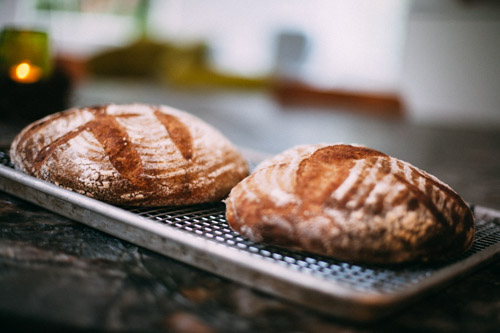
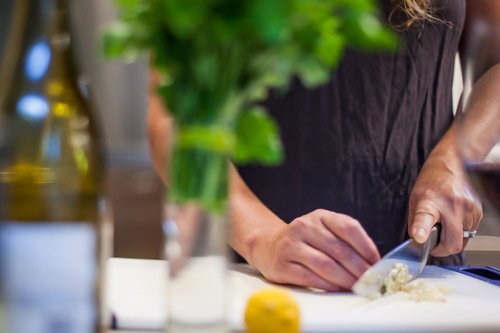
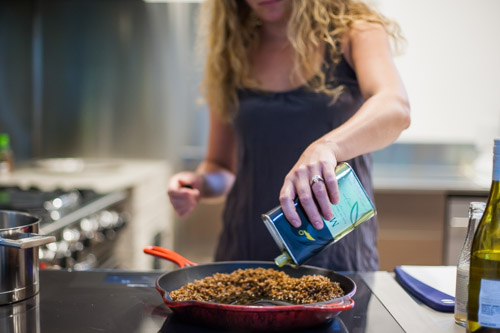
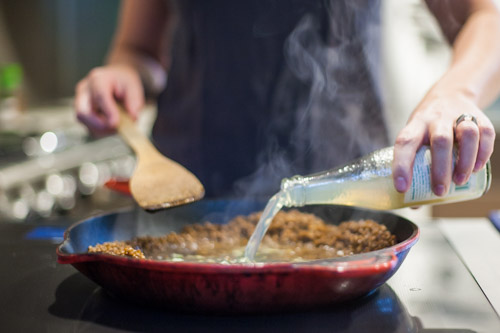
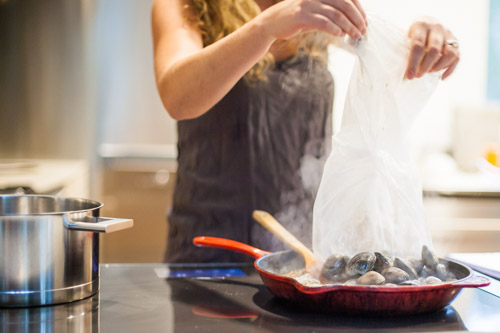
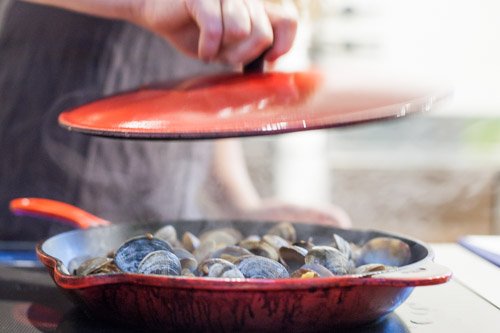
Originally published: July 05, 2015
















